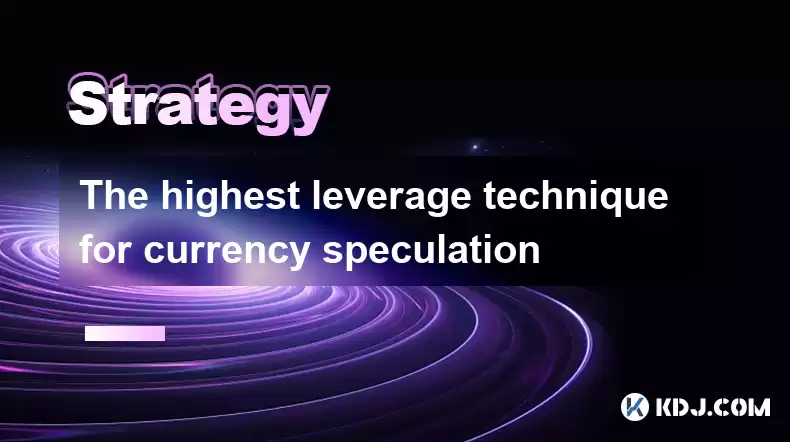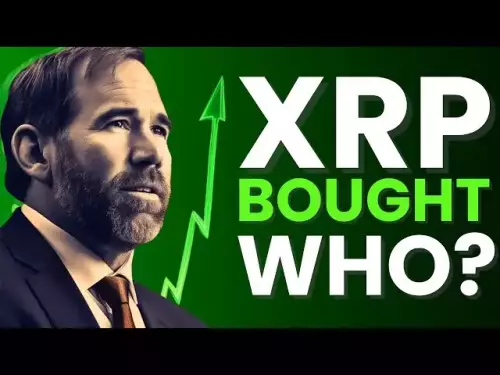-
 bitcoin
bitcoin $108842.957301 USD
-1.88% -
 ethereum
ethereum $3931.777121 USD
-1.66% -
 tether
tether $1.000186 USD
-0.03% -
 bnb
bnb $1153.250882 USD
-2.20% -
 xrp
xrp $2.367904 USD
-1.94% -
 solana
solana $186.182050 USD
-4.20% -
 usd-coin
usd-coin $0.999997 USD
0.00% -
 tron
tron $0.316949 USD
-1.00% -
 dogecoin
dogecoin $0.190780 USD
-3.12% -
 cardano
cardano $0.651324 USD
-2.67% -
 hyperliquid
hyperliquid $37.141055 USD
-0.85% -
 ethena-usde
ethena-usde $0.999224 USD
-0.09% -
 chainlink
chainlink $17.579031 USD
-2.47% -
 bitcoin-cash
bitcoin-cash $509.426284 USD
-2.79% -
 stellar
stellar $0.315298 USD
-2.93%
The highest leverage technique for currency speculation
By understanding how leverage works and choosing the appropriate ratio for your trading strategy, you can harness its potential to increase profits while managing potential risks effectively.
Jan 08, 2025 at 07:40 pm

- Leverage and its role in currency speculation
- Different levels of leverage and their risks
- Choosing the right leverage for your trading strategy
- Managing risk with leverage
- Alternatives to high leverage trading
Unlocking the Highest Leverage Technique for Currency Speculation
Currency speculation, also known as foreign exchange (forex) trading, involves buying and selling currencies in order to profit from changes in their exchange rates. One of the most important factors in currency speculation is the use of leverage.
1. Understanding LeverageLeverage is a financial instrument that allows traders to borrow capital from their broker to increase their trading size. It is expressed as a ratio, such as 10:1 or 50:1. For example, a leverage of 10:1 means that a trader can control $10 worth of currency for every $1 they deposit with their broker.
2. Different Levels of LeverageDifferent brokers offer different levels of leverage to their clients. The most common leverage levels are:
- 10:1: This is considered a low leverage ratio and is suitable for beginners or conservative traders.
- 50:1: This is a moderate leverage ratio that is commonly used by experienced traders.
- 100:1: This is a high leverage ratio that is only suitable for experienced and aggressive traders.
The appropriate level of leverage depends on your individual trading style, risk tolerance, and experience. Beginners should start with a low leverage ratio until they gain experience and become more comfortable with trading. More experienced traders may be able to tolerate higher leverage, but they should always be aware of the risks involved.
4. Managing Risk with LeverageLeverage can be a powerful tool for increasing profits, but it also comes with increased risk. As the leverage ratio increases, the potential for losses also increases. Traders should always use stop-loss orders to limit their potential losses.
5. Alternatives to High Leverage TradingIf you are not comfortable with the risks associated with high leverage trading, there are other ways to increase your trading size without borrowing from your broker. These include:
- Increasing your account balance: This is the safest way to increase your trading size without increasing your risk.
- Using a micro account: Micro accounts allow traders to trade with a smaller lot size, which reduces the potential for losses.
- Trading exotic currencies: Exotic currencies are generally much more volatile than major currencies, which can provide an opportunity for higher returns. However, they also carry significantly more risk.
FAQs
Q: What is the maximum leverage allowed in currency speculation?A: The maximum leverage allowed varies depending on the broker, but most brokers offer a maximum leverage of 100:1.
Q: Is it possible to make a profit without using leverage?A: Yes, it is possible to make a profit without using leverage. However, it will take longer to accumulate significant profits.
Q: Can I use leverage to trade stocks?A: Leverage is typically only used for trading currencies and CFDs. It is not commonly used for trading stocks.
Disclaimer:info@kdj.com
The information provided is not trading advice. kdj.com does not assume any responsibility for any investments made based on the information provided in this article. Cryptocurrencies are highly volatile and it is highly recommended that you invest with caution after thorough research!
If you believe that the content used on this website infringes your copyright, please contact us immediately (info@kdj.com) and we will delete it promptly.
- Dogecoin's Wild Ride: Market Turmoil and Price Decline Explained
- 2025-10-17 18:25:12
- Newsmax, Crypto, and the Frontier of Corporate Finance: A New Yorker's Take
- 2025-10-17 18:45:16
- XRP Price, 2030 Prediction, Crypto Presale: Decoding the Future
- 2025-10-17 18:25:12
- Paxos' PYUSD "Oops!" Moment: 300 Trillion Tokens and Crypto's Wild Ride
- 2025-10-17 18:45:16
- Trump, Crypto, and Political Power: A New Coin and a Market Correction
- 2025-10-17 18:50:12
- Bubblemaps, ChainOpera, and COAI Profits: A Deep Dive into the BNB Ecosystem
- 2025-10-17 18:30:13
Related knowledge

Practical parameter settings for a Bitcoin multi-timeframe moving average system
Sep 18,2025 at 10:54pm
Optimizing Timeframe Combinations for Bitcoin Trading1. Selecting appropriate timeframes is crucial when building a multi-timeframe moving average sys...

How can I filter out false breakouts in Dogecoin high-frequency trading?
Sep 22,2025 at 01:00am
Understanding False Breakouts in Dogecoin Trading1. A false breakout occurs when Dogecoin's price appears to move beyond a defined support or resistan...

Techniques for identifying tops and bottoms in the Bitcoin on-chain NVT model
Sep 20,2025 at 07:54pm
Understanding the NVT Model in Bitcoin Analysis1. The Network Value to Transactions (NVT) ratio is often described as the 'P/E ratio' of the cryptocur...

What does the surge in open interest in Bitcoincoin futures mean?
Sep 20,2025 at 11:18pm
Understanding the Surge in Dogecoin Futures Open Interest1. A surge in open interest within Dogecoin futures indicates a growing number of active cont...

How can I use the Ethereum USDT premium to gauge market sentiment?
Sep 18,2025 at 11:55pm
Understanding the Ethereum USDT Premium1. The Ethereum USDT premium refers to the price difference between USDT (Tether) traded on Ethereum-based plat...

What should I do if Ethereum staking yields decline?
Sep 20,2025 at 06:18am
Understanding the Causes Behind Declining Ethereum Staking Yields1. The Ethereum network transitioned to a proof-of-stake consensus mechanism with the...

Practical parameter settings for a Bitcoin multi-timeframe moving average system
Sep 18,2025 at 10:54pm
Optimizing Timeframe Combinations for Bitcoin Trading1. Selecting appropriate timeframes is crucial when building a multi-timeframe moving average sys...

How can I filter out false breakouts in Dogecoin high-frequency trading?
Sep 22,2025 at 01:00am
Understanding False Breakouts in Dogecoin Trading1. A false breakout occurs when Dogecoin's price appears to move beyond a defined support or resistan...

Techniques for identifying tops and bottoms in the Bitcoin on-chain NVT model
Sep 20,2025 at 07:54pm
Understanding the NVT Model in Bitcoin Analysis1. The Network Value to Transactions (NVT) ratio is often described as the 'P/E ratio' of the cryptocur...

What does the surge in open interest in Bitcoincoin futures mean?
Sep 20,2025 at 11:18pm
Understanding the Surge in Dogecoin Futures Open Interest1. A surge in open interest within Dogecoin futures indicates a growing number of active cont...

How can I use the Ethereum USDT premium to gauge market sentiment?
Sep 18,2025 at 11:55pm
Understanding the Ethereum USDT Premium1. The Ethereum USDT premium refers to the price difference between USDT (Tether) traded on Ethereum-based plat...

What should I do if Ethereum staking yields decline?
Sep 20,2025 at 06:18am
Understanding the Causes Behind Declining Ethereum Staking Yields1. The Ethereum network transitioned to a proof-of-stake consensus mechanism with the...
See all articles










































































